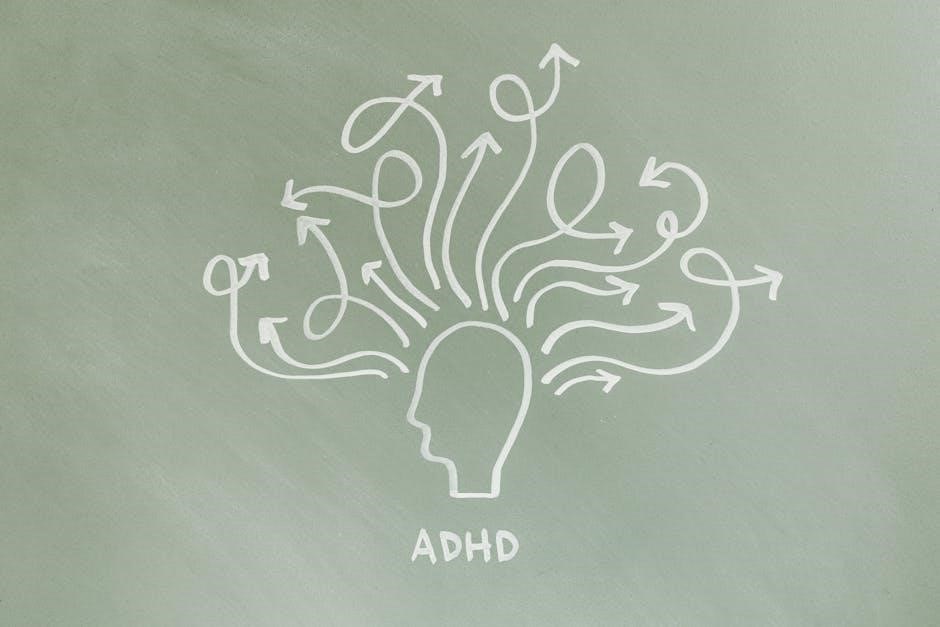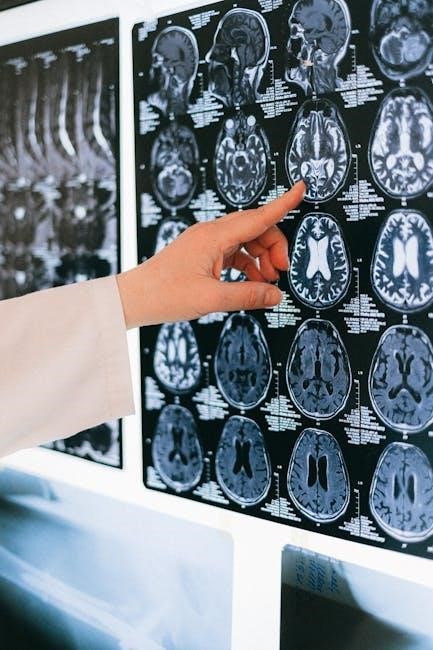The Brain That Changes Itself by Norman Doidge explores the revolutionary concept of neuroplasticity, revealing how the brain can rewire and adapt throughout life, challenging traditional views of brain rigidity.
1.1 Overview of the Book
The Brain That Changes Itself by Norman Doidge is a groundbreaking exploration of neuroplasticity, the brain’s ability to rewire and adapt throughout life. The book challenges the long-held belief that the brain is fixed after adulthood, presenting compelling evidence of its remarkable capacity for change. Through a series of case studies and scientific insights, Doidge illustrates how individuals have overcome brain injuries, learning disorders, and emotional traumas by harnessing neuroplasticity. The book also delves into the historical shift in neuroscience, highlighting pioneers who challenged the idea of a rigid brain. Doidge’s engaging narrative weaves personal stories with scientific breakthroughs, offering hope and insight into the brain’s potential for transformation. This work has been widely praised for its accessibility and depth, making complex concepts understandable for a broad audience.
1.2 Importance of Neuroplasticity
Neuroplasticity, the brain’s ability to reorganize itself, is a revolutionary concept that challenges the long-held belief that the brain is fixed after adulthood. This discovery has profound implications for healing, learning, and personal growth. By understanding neuroplasticity, scientists and clinicians can develop new treatments for brain injuries, stroke recovery, and neurological disorders. It also offers insights into improving cognitive function and emotional well-being. The brain’s adaptability empowers individuals to rewire their thoughts, behaviors, and responses, opening doors to lifelong learning and transformation. This concept underscores the brain’s resilience and potential for change, making it a cornerstone of modern neuroscience and a source of hope for millions seeking to overcome challenges and enhance their lives.

The Concept of Neuroplasticity
Neuroplasticity refers to the brain’s remarkable ability to adapt, reorganize, and change throughout life, enabling recovery from injuries and enhancing cognitive, emotional, and behavioral functions.
2;1 Definition and Explanation
Neuroplasticity is the brain’s extraordinary ability to reorganize itself by forming new neural connections throughout life. This concept challenges the long-held belief that the brain is fixed after a certain age. It explains how the brain adapts, compensates, and evolves in response to new experiences, environments, or injuries. Neuroplasticity occurs at various levels, from microscopic changes in individual neurons to larger-scale remapping of brain areas. This adaptability is crucial for learning, recovery from brain damage, and overcoming cognitive or emotional challenges. The discovery of neuroplasticity has revolutionized neuroscience, offering hope for individuals with neurological or psychiatric conditions. It demonstrates that the brain is not static but a dynamic, ever-changing entity capable of remarkable transformation.
2.2 Historical Development
Neuroplasticity has evolved significantly over centuries, transitioning from a dismissed idea to a cornerstone of modern neuroscience. Historically, the brain was viewed as a fixed, unchangeable entity after early development, a belief perpetuated by the medical and scientific communities. However, pioneers like Santiago Ramón y Cajal began challenging this notion in the late 19th century, suggesting that neurons could form new connections. In the 20th century, researchers like Marian Diamond demonstrated structural brain changes in response to environment, and Paul Bach-y-Rita explored sensory reorganization. These discoveries laid the groundwork for understanding neuroplasticity as a dynamic, lifelong process. Norman Doidge’s work in “The Brain That Changes Itself” compiles these breakthroughs, illustrating how neuroplasticity revolutionized approaches to brain recovery and adaptation, offering hope for overcoming previously deemed irreversible conditions.

Author Norman Doidge
Norman Doidge, a psychiatrist and researcher, is renowned for his work in neuroplasticity. His book, The Brain That Changes Itself, highlights groundbreaking discoveries in brain adaptability and recovery.
3.1 Background and Expertise
Norman Doidge, a psychiatrist, psychoanalyst, and researcher, has extensive expertise in neuroscience and neuroplasticity. He has served on the faculty of the University of Toronto’s Department of Psychiatry and as a research faculty member at Columbia University’s Center for Psychoanalytic Training and Research. Doidge’s work focuses on the brain’s ability to rewire itself, challenging the long-held belief that the brain is fixed after adulthood. His research and clinical practice have centered on understanding how neuroplasticity can be harnessed for healing and personal transformation. Doidge’s unique approach combines scientific rigor with compelling storytelling, making complex concepts accessible to a broad audience. His contributions have significantly advanced the field of neuroscience and inspired new approaches to treating brain injuries and psychological disorders.
3.2 Contributions to Neuroplasticity
Norman Doidge has made significant contributions to the field of neuroplasticity through his groundbreaking research and writings. His book, The Brain That Changes Itself, revolutionized public understanding of brain adaptability, showcasing how the brain can rewire itself in response to injury, learning, or environmental changes. Doidge’s work bridges neuroscience and clinical practice, offering hope for recovery from conditions once considered irreversible. By documenting case studies and interviewing pioneers in neuroplasticity, he has illuminated the brain’s remarkable capacity for transformation. His contributions have also emphasized the role of mental practices, such as visualization and mindfulness, in reshaping brain structure and function. Doidge’s efforts have inspired new therapies and approaches, making neuroplasticity accessible to both scientists and the general public. His work continues to influence modern neuroscience and rehabilitation practices.
Case Studies in Neuroplasticity
The book highlights remarkable case studies, such as a woman born with half a brain who adapted to lead a normal life, demonstrating neuroplasticity’s transformative potential.
4.1 Personal Stories of Transformation
Norman Doidge shares inspiring personal stories of individuals who transformed their lives through neuroplasticity. A woman born with half a brain rewired herself to function normally, while blind individuals learned to “see” through sound. Stroke victims regained speech and mobility, and those with cerebral palsy improved their movement. These stories highlight the brain’s remarkable adaptability and challenge the notion of fixed neurological limits. Doidge’s narratives inspire awe, offering hope for recovery and growth. By focusing on real-life triumphs, he illustrates how neuroplasticity reshapes lives, proving the brain’s extraordinary capacity for change and self-repair. These personal journeys are not just medical marvels but also testament to human resilience and the brain’s boundless potential for transformation.
4.2 Scientific Case Studies
Scientific case studies in “The Brain That Changes Itself” provide profound insights into neuroplasticity’s mechanisms. Researchers document how brain exercises, thought control, and sensory training reshaped neural pathways. A study on individuals with brain damage showed remarkable recovery through targeted therapies. Blind individuals learned to “see” through sound, demonstrating cross-sensory plasticity. Stroke patients regained speech and motor skills by engaging new brain areas. These studies challenge the idea of a fixed brain, proving that neuroplasticity enables structural and functional changes. Doidge highlights experiments at institutions like Columbia University, showcasing breakthroughs in brain adaptability; These scientific advancements not only validate neuroplasticity but also open doors to innovative treatments for brain injuries, disorders, and cognitive enhancement, revolutionizing neuroscience and human potential.

Applications and Implications
Neuroplasticity’s applications span medical, educational, and psychological fields, offering innovative treatments for brain injuries, learning disorders, and mental health conditions. Its implications revolutionize how we approach human potential, education, and personal growth, emphasizing the brain’s lifelong adaptability and the power of targeted interventions to enhance cognitive and emotional well-being.
5.1 Medical and Therapeutic Applications
Neuroplasticity has revolutionized medical and therapeutic approaches, offering hope for individuals with brain injuries, strokes, and neurological disorders. Techniques like neurorehabilitation and cognitive training leverage the brain’s adaptability to restore lost functions. Stroke patients regain speech and mobility, while those with traumatic brain injuries improve cognitive abilities. Non-invasive therapies, such as transcranial magnetic stimulation (TMS) and transcranial direct current stimulation (tDCS), are being used to treat depression and anxiety by reshaping brain circuits. Neuroplasticity-based interventions also address learning disorders, ADHD, and autism, providing personalized therapies that enhance brain function. These advancements challenge the notion of a fixed brain, offering new pathways for healing and recovery.
5.2 Educational and Psychological Implications
Neuroplasticity reshapes education and psychology, offering innovative approaches to learning and mental well-being. By understanding the brain’s adaptability, educators can develop personalized strategies to enhance learning and improve academic outcomes. Techniques like mindfulness and cognitive training are being integrated into classrooms to boost memory, attention, and problem-solving skills. In psychology, neuroplasticity-based therapies are transforming the treatment of mental health disorders, such as depression and anxiety, by teaching patients to rewire negative thought patterns. This concept also challenges traditional beliefs about intelligence and talent, emphasizing that abilities can be developed through practice and effort. These insights empower individuals to take control of their cognitive and emotional growth, fostering lifelong resilience and personal development.

The Future of Brain Science
Emerging technologies and neuroplasticity research promise groundbreaking advancements, offering new treatments for brain disorders and enhancing human cognition, memory, and adaptability, reshaping the future of neuroscience.
6.1 Emerging Trends and Technologies
Emerging trends in brain science include advanced neuroimaging, AI-driven diagnostics, and non-invasive brain stimulation techniques, enabling deeper insights into neuroplasticity.
These technologies are revolutionizing how we understand and treat brain disorders, offering personalized approaches to cognitive enhancement.
For instance, transcranial magnetic stimulation (TMS) and transcranial direct current stimulation (tDCS) are being refined to enhance neuroplasticity.
Additionally, wearable neurotechnology and brain-computer interfaces are paving the way for real-time monitoring and intervention.
Gene therapy and stem cell research also hold promise for repairing damaged brain tissue.
These innovations are not only advancing medical treatments but also opening new possibilities for human performance and adaptation, making the future of brain science incredibly exciting and transformative.
6.2 Potential Breakthroughs and Challenges
Future breakthroughs in brain science may include advanced therapies leveraging neuroplasticity, such as personalized treatments for stroke recovery and brain injuries.
Non-invasive technologies like transcranial magnetic stimulation (TMS) and direct current stimulation (tDCS) could become more refined, offering precise neural circuit adjustments.
However, challenges remain, such as ethical concerns over enhancing cognition in healthy individuals.
Ensuring equitable access to neurotechnologies and balancing therapeutic benefits with potential risks is critical.
Additionally, understanding the brain’s complexity and avoiding unintended side effects of interventions pose significant scientific hurdles.
Despite these challenges, the potential to unlock new ways to heal, learn, and adapt makes neuroplasticity research a promising yet complex frontier.




About the author